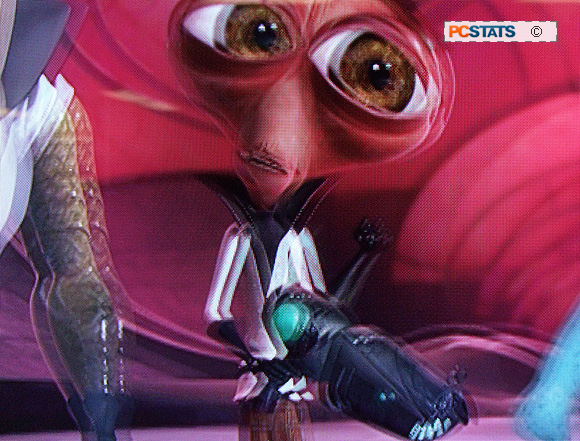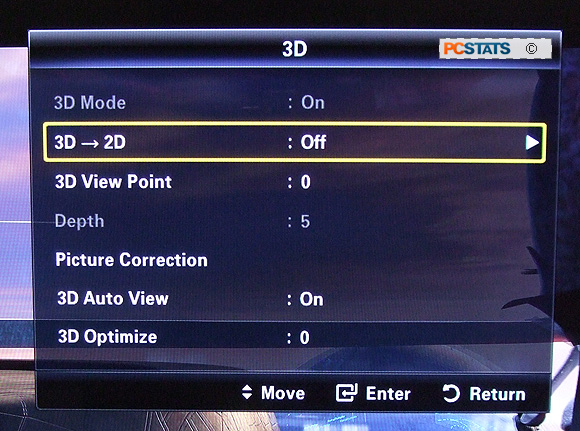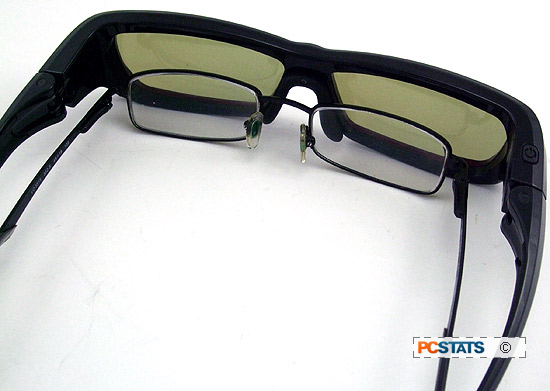Viewer experience with 3D can depend on the person. For example, a few
visitors in the PCSTATS test labs were asked to try out the Samsung UN55C7000's
3D mode and tell us what they saw, for each it was the first time
viewing a home 3D-HDTV. While some reported that the picture was flickery
or difficult to focus on even in ideal conditions, others could view the 3D
effects with no problems at all, and immediately fell in love with the
UN55C7000. It's some thing you'll definitely need to test yourself before
putting money down on a display like this, but if you are giving it a test drive
make sure the glasses are calibrated to the display directly in front of you
first.
How does the 3D work?
The 3D effect is achieved
by having the Samsung UN55C7000 flashing two images at once on the screen
very quickly (each one is flashed 120 times per second, or 120Hz), one for the left
eye and one for the right eye. If you stare at the screen when it's like this
you'll see it's just a blurry mess, both of your eyes are seeing two images at
once, and can't separate them into proper pictures.

This is where the active 3D glasses come in. The left and right liquid crystal lens blink on
and off alternatively at a rate of 120Hz each, so that each lens only
effectively 'sees' for 50% of the time, and this blinking is kept in sync
with the UN55C7000's 3D output. In the end the glasses make your left eye only see
the left image, your right eye sees the right image, and when you
put the two together you get stereoscopic 3D.
What do I need to use it?
To get the optimum viewing
experience, you actually need quite a bit.
First you'll need a
120Hz to 240hz 3D-capable display, which comes in the form of the
$3300 Samsung UN55C7000. Next each person watching the Samsung UN55C7000 in 3D mode has
to have a $150-$199 set of Samsung's proprietary electronic shutter glasses on,
or the TV will simply look blurry.
Then you'll need a special $399 3D Blu-Ray player which can
output 1080p content at 120Hz. Finally you'll need some properly encoded 3D
Blu-ray content, which will cost about $30.
It's kind of telling why the electronics industry is so excited about 3DTV...
if you want the full experience you could be buying up to
$5000 worth of equipment to get you, your spouse
and your 2 children watching 3D movies together. Do you need special content to watch
3D? Well, yes and no...
Do you need special 3D content?
To get the best experience out
of stereoscopic 3D, you'll want a 3D encoded Blu-ray disc (and a 3D Blu-ray
player to run it on). It's the only format where 3D content will appear to
flying out at you, along with showing depth going into the screen.
Right now there are only a handful of 3D Blu-Ray movie titles available,
most of which are family-friendly CGI movies like Monsters Vs. Aliens
3D, Cloudy with a Chance of Meatballs 3D, Polar
Express 3D, Avatar
3D etc.

Fortunately Samsung has made it possible to turn boring, flat 2D content into
glorious, immersive 3D. A 3D algorithm on the UN55C7000 can transform most visual
content into a fair approximation of 3D. This 2D to 3D conversion is at its best
when paired with a high-definition 1080p video source, with content that has
plenty of contrast and sharp lines (think CGI movies like Star Wars: The Clone
Wars). The converted effect looks pretty close to a 3D-encoded Blu-ray
disc, with the biggest difference that the Blu-Ray will
show 3D images that pop out towards the viewer and depth
going away from the viewer and into the screen. Converted 2D-to-3D
feeds won't pop-out at you, they'll only show
depth going into the background.
In some cases 2D-to-3D conversion doesn't work so well. With
certain scenes the technology simply isn't able to tell what should be in
the foreground and what should be in the background, resulting in an image
that's mostly flat. In other cases it'll bring the wrong elements forwards, and
you'll be starting at scenes where somehow things in the background look like
they're in front of foreground characters. It's like staring at an MC Escher
optical illusion, and can be very distracting and even
headache-inducing when it crops up.
Can I surf the net/play games/do other things in
3D?
Here's an informative chart that will explain what does and doesn't work in
3D, and how well the 3D effect works if you can turn it on.
|
3D
Chart |
|
3D Blu-Ray |
2D->3D conversion, HD source |
2D->3D conversion, SD
Source |
2D->3D conversion, still image
|
2D->3D conversion, computer
desktop |
2D->3D conversion, computer
gaming |
2D->3D conversion, Samsung
Internet@TV |
|
The best 3D experience, gives you the chance to
see objects popping out of the screen towards you, no
foreground/background confusion. Some people may experience ghosting and
flickering on extreme foreground objects. |
Can look good when paired with certain types of content,
like CGI movies. Depth can at times be rendered incorrectly, which is
distracting. |
The blurrier edges of SD content don't lend themselves to
3D conversion, the result is a 3D image that looks relatively flat.
|
A mixed bag. Depending on the photo there may be
some depth added using 3D conversion, but as often as not
the depth doesn't match the perspective of the image, leading to
the "MC Escher" effect. |
Since the computer desktop is a flat 2D plane, turning on
3D simply makes some desktop icons and UI elements have the illusion of
depth, but for the most part this doesn't change or add much to the usage
experience. |
Gaming on a connected PC or game console works partially,
with UI elements and some foreground imagery showing depth, but inaccurate
depth rendering can make it difficult and disorienting to play games in 3D
for extended periods of time. |
Not supported by the Samsung UN55C7000. 3D modes cannot be
activated while using Internet@TV content like the embedded
Youtube, Picasa or Skype applications. |
Can
anyone use it, even if they have glasses?
Samsung's 3D Glasses are large enough to fit over most pairs of glasses worn
by adults, so unless you happen to be a hipster or Lady Gaga you
shouldn't have trouble getting them on. The 3D shutter
glasses that Samsung included for this review of the UN55C7000 have a built-in
rechargeable battery (recharges via USB using a proprietary cable).

One of the reoccuring questions we've fielded often
while testing the Samsung UN55C7000 3D-HDTV is how long you can watch before
eyestrain happens (or if it happens at all). Here's what we found...
